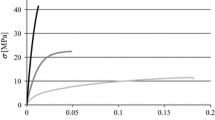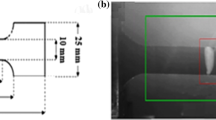Abstract
In this study, lap shear strength as well as specific fracture energy of bonded specimens from spruce wood were determined in order to verify whether the calculation of adhesive fracture energy is a suitable tool for the mechanical characterization of different adhesive systems, especially in comparison to the commonly used lap joint test method according to the European standard method EN 302-1. Two different test methods were applied for measuring the fracture energy by using a double cantilever beam (DCB). For both methods the DCB is separated along the bond in mode I fracture. While both adhesive systems applied showed similar shear strength values, differences were much more pronounced regarding the specific fracture energy of the bonded joints. Especially the application of the fracture energy concept, i.e., the separation of the DCB in a single load cycle, provided results with higher informative value than the results of standard lap shear tests.
Zusammenfassung
Im Rahmen dieser Untersuchung wurde die Längszugscherfestigkeit sowie die spezifische Bruchenergie an verklebten Prüfkörpern aus Fichtenholz ermittelt. Es sollte die Eignung der Bruchenergieprüfung im Vergleich zur derzeit häufig eingesetzten standardisierten Längszugscherprüfung nach EN 302-1 zur mechanischen Charakterisierung verschiedener Klebstoffsysteme untersucht werden. Die Bruchenergie wurde an Zugspaltproben unter Verwendung zweier unterschiedlicher Methoden bestimmt. Bei beiden Methoden fand eine Trennung der Proben entlang der Klebfuge statt, die Rissbelastung erfolgte jeweils im Modus I. Während sich die beiden verwendeten Klebstoffsysteme hinsichtlich der Längszugscherfestigkeit der Verklebungen kaum voneinander unterschieden, konnten teils deutliche Unterschiede in der Bruchenergie festgestellt werden. Vor allem bei Anwendung des Bruchenergiekonzeptes, d.h. wenn die Trennung der Zugspaltprobe in einem einzigen Belastungszyklus erfolgt, scheint die Aussagekraft der Ergebnisse für die Charakterisierung der Verklebungsgüte höher zu sein, als dies bei der Längszugscherprüfung der Fall ist.





Similar content being viewed by others
References
Blackman B, Dear JP, Kinloch AJ, Osiyemi S (1991) The calculation of adhesive fracture energies from double-cantilever beam test specimens. J Mater Sci Lett 10(5):253–256
De Bruyne NA, Houwink R (1957) Klebtechnik – Die Adhäsion in Theorie und Praxis. Berliner Union, Stuttgart
DIN 53 253 (1964) Prüfung von Holzleimen und Holzverleimungen, Bestimmung der Bindefestigkeit von Schäftverleimungen im Zugversuch. Deutscher Normenausschuss, Berlin
Ebewele R, River BH, Koutsky JA (1979) Tapered double cantilever beam fracture tests of phenolic-wood adhesive joints. Part 1. Development of specimen geometry: effects of bondline thickness, wood anisotropy and cure time on fracture energy. Wood Fiber Sci 11(3):197–21
Eckmann R (2007) Charakterisierung der adhäsiven, kohäsiven und mechanischen Eigenschaften der Klebfuge in einer Holzverklebung. Dissertation, Universität für Bodenkultur Wien
EN 205 (2003) Klebstoffe – Holzklebstoffe für nicht tragende Anwendungen – Bestimmung der Klebfestigkeit von Längsklebungen im Zugversuch. Österreichisches Normungsinstitut, Wien
EN 302-1 (2004) Klebstoffe für tragende Holzbauteile – Prüfverfahren – Teil 1: Bestimmung der Längszugscherfestigkeit. Österreichisches Normungsinstitut, Wien
Frühmann K, Burgert I, Stanzl-Tschegg SE, Tschegg EK (2003) Mode I fracture behaviour on the growth ring scale and cellular level of spruce (Picea abies [L.] Karst.) and beech (Fagus sylvatica L.) Loaded in the TR crack propagation system. Holzforschung 57(6):653–660
Furuno T, Saiki H, Goto T, Harada H (1983) Penetration of glue into the tracheid lumina of softwood and the morphology of fractures by tensile-shear tests. Mokuzai Gakkaishi 29(1):43–53
Gagliano JM (2001) An improved method for the fracture cleavage testing of adhesively-bonded wood. MS thesis, Virginia Polytechnic Institute and State University Blacksburg
Gagliano JM, Frazier CE (2001) Improvements in the fracture cleavage testing of adhesively-bonded wood. Wood Fiber Sci 33(3):377–385
Gindl W, Teischinger A, Konnerth J, Müller U (2006) Prüfung der Verklebungsfestigkeit mit der Schäftprobe. Holz-Zentbl 132(16):460–461
Harm M (2006) Vergleich dreier Verfahren zur Bestimmung der Verklebefestigkeit von Vollholz. Diplomarbeit, Universität für Bodenkultur Wien
Irwin GR, Kies JA (1954) Critical energy rate analysis of fracture strength. Weld J 33(4):193–198
Keunecke D, Stanzl-Tschegg S, Niemz P (2007) Fracture characterisation of yew (Taxus baccata L.) and spruce (Picea abies [L.] Karst.) in the radial-tangential and tangential-radial crack propagation system by a micro wedge splitting test. Holzforschung 61(5):582–588
Konnerth J, Gindl W, Harm M, Müller U (2006a) Comparing dry bond strength of spruce and beech wood glued with different adhesives by means of scarf- and lap joint testing method. Holz Roh-Werkst 64(4):269–271
Konnerth J, Gindl W, Müller U (2006b) Elastic properties of adhesive polymers. I. Polymer films by means of electronic speckle pattern interferometry. J Appl Polym Sci 103(6):3936–3939
Künniger T (2009) Methode zur Quantifizierung des prozentualen Faserbruchanteils an Scherproben. Holztechnologie 50(2):26–31
Lavisci P, Pizzo B, Gagliano JM, Triboulot P, De Ciechi M (2003) Fracture energy testing of thick joints with structural wood adhesives. Holz Roh-Werkst 61(5):355–357
Matthews FL, Rawlings RD (1999) Composite materials: engineering and science. Woodhead Publishing Ltd, Abington
Mijovic JS, Koutsky JA (1979) Effect of wood grain angle on fracture properties and fracture morphology of wood-epoxy joints. Wood Sci 11(3):164–168
Müller U, Sretenovic A, Vincenti A, Gindl W (2005) Direct measurement of strain distribution along a wood bond line. Part 1: Shear strain concentration in a lap joint specimen by means of electronic speckle pattern interferometry. Holzforschung 59(3):300–306
Reiterer A, Sinn G, Stanzl-Tschegg SE (2002) Fracture characteristics of different wood species under mode I loading perpendicular to the grain. Mater Sci Eng A Struct 332(1–2):29–36
River BH, Okkonen EA (1993) Contoured wood double cantilever beam specimen for adhesive joint fracture tests. J Test Eval 21(1):21–28
Sell J (1989) Eigenschaften und Kenngrössen von Holzarten. Baufachverlag, Zürich
Stanzl-Tschegg SE, Tan DM, Tschegg EK (1995) New splitting method for wood fracture characterization. Wood Sci Technol 29(1):31–50
Zhou A, Lesko J (2006) Polymers and adhesives for the infrastructure. Showcase on Virginia fiber-reinforced composites: materials, design, and construction, Bristol. http://www.virginiadot.org/business/resources/bridge-02PolymersAdhesives.pdf. Accessed 21 January 2010
Acknowledgements
The authors gratefully acknowledge financial support by the Competence Centre for Wood Composites and Wood Chemistry (Wood K plus) as well as by the Austrian Science Fund (FWF) under grant P21681.
Author information
Authors and Affiliations
Corresponding author
Rights and permissions
About this article
Cite this article
Veigel, S., Follrich, J., Gindl-Altmutter, W. et al. Comparison of fracture energy testing by means of double cantilever beam-(DCB)-specimens and lap joint testing method for the characterization of adhesively bonded wood. Eur. J. Wood Prod. 70, 3–10 (2012). https://doi.org/10.1007/s00107-010-0499-6
Received:
Published:
Issue Date:
DOI: https://doi.org/10.1007/s00107-010-0499-6




